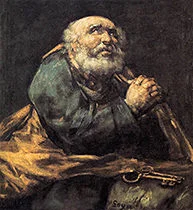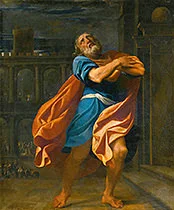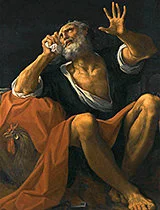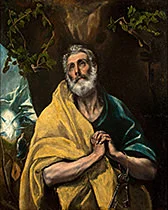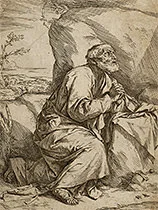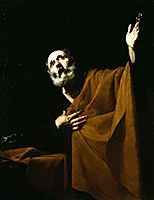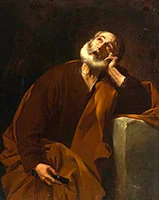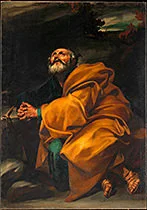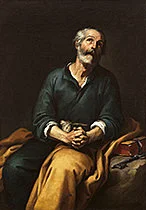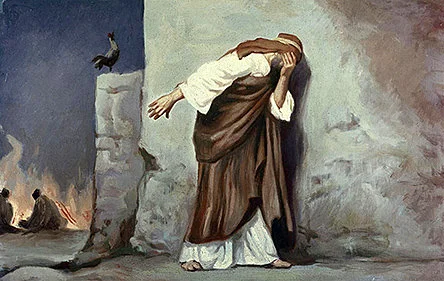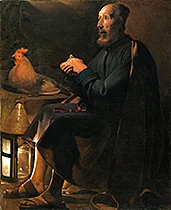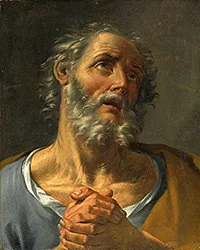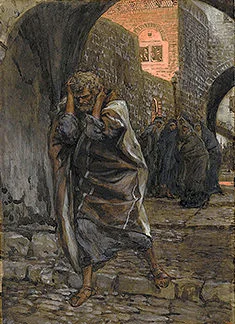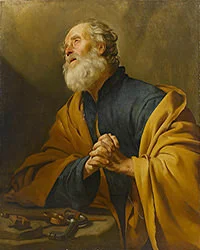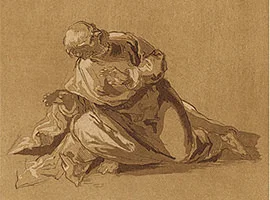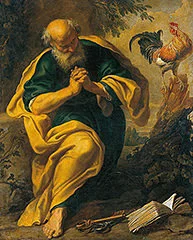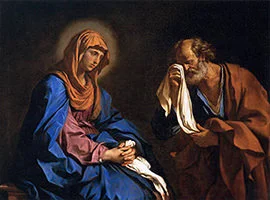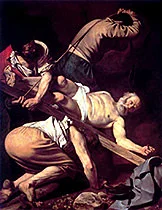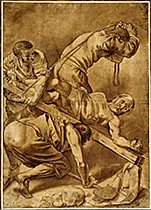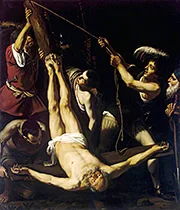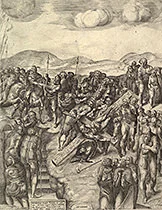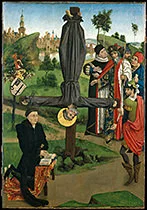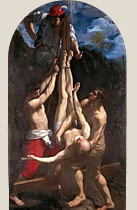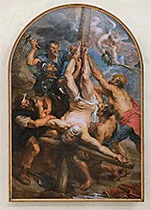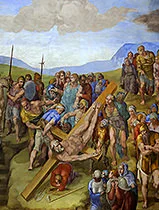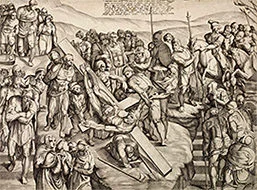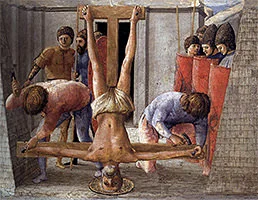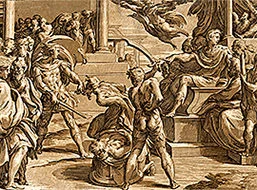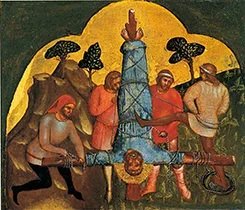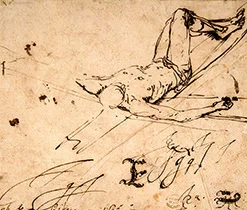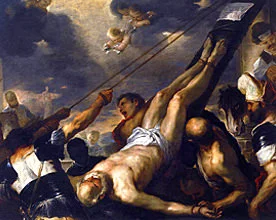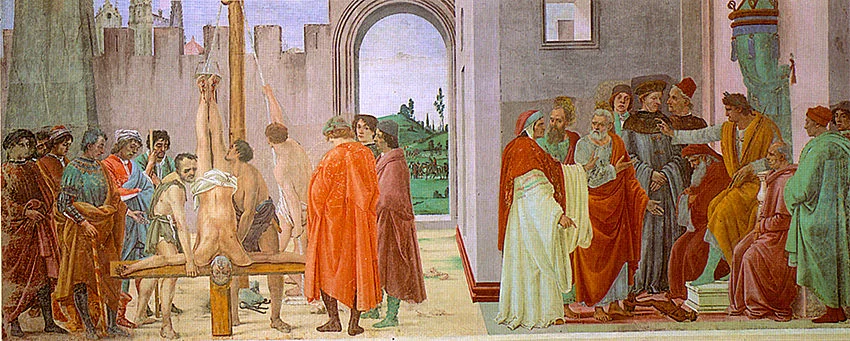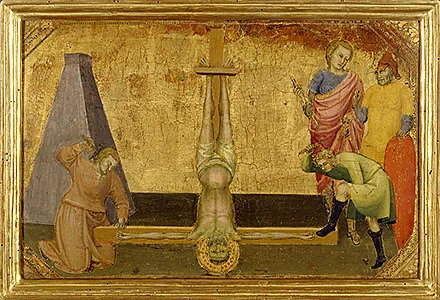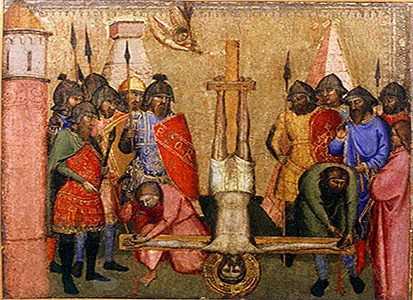The Art World Commemorates Peter
— Album 16 of 17 Photo Albums —
Warren Camp’s presentation of 550 famous “Peter” works of art includes historic paintings, frescoes, stained glass, etchings, sculptures, engravings, and other artwork monuments. They come from the Gothic (1100–1400), High Renaissance, Baroque, Rococo, Neoclassical, and Romantic (1800s) eras.
All are popular works, designed and created by celebrated artists, many of whom you’ll likely recognize, including Rembrandt, Raphael, Michelangelo, El Greco, Da Vinci, Masaccio, Huret, Galle, Tissot, Botticelli, Dürer, Rubens, and many more. They’ll bring back recollections of your “Art History 101” classes, using Janson’s History of Art textbook.
Whether depicting “Cephas,” “Petrus,” “Simon,” “Simeon,” “Simon Bar-Jonah,” “Simon Peter,” “The Rock,” “Peter,” “Apostle Peter,” or “Saint Peter,” the enlarged images of this acclaimed Bible figure come with factual and enlightening details: the artist’s bio; when each work was created; where it can be seen; applicable Bible passages; background and highlights of each work; and photo sources with copyright notices.
To appreciate the impact that Peter had on numerous art-world masters, be sure to click each thumbnail to enlarge it.
• These photo albums complement the Bible-study commentaries Warren has written for “1st and 2nd Peter,” found here.
…
Album 1 (Peter, alone) | Album 2 | Album 3 | Album 4 | Album 5
Album 6 | Album 7 | Album 8 | Album 9 | Album 10 | Album 11
Album 12 | Album 13 | Album 14 | Album 15 | Album 16 | Album 17
Album topics are shown at the [ ⇓ bottom ⇓ ] of each page.
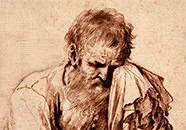
Repentant Peter
Saint Peter”
Slide 6
Click to enlarge.
Jusepe de Ribera
(Lo Spagnoletto)
1628–1632
oil on canvas
Saint Peter”
Slide 7
Click to enlarge.
Jusepe de Ribera
(Lo Spagnoletto)
c. 1628
oil on canvas
“San Pietro Penitente”
Slide 8
Click to enlarge.
De Ribera — c. 1613
oil on canvas
Slide 15
Click to enlarge.
Adam von Bartsch
1785
etching and aquatint on paper
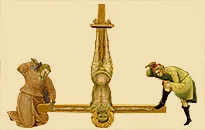
Peter’s Martyrdom/Crucifixion
of Saint Peter”
Slide 21
Click to enlarge.
Lucchese — 1550–1560
etching with engraving
St Peter with a Donor”
Slide 22
Click to enlarge.
French Painter — c. 1450
oil on wood
of Saint Peter”
Slide 26
Click to enlarge.
Giovanni Cavalieri — c. 1567
engraved print on paper
Saints Peter and Paul”
Slide 28
Click to enlarge.
Antonio da Trento — c. 1530
woodcut on laid paper
Slide 29
Click to enlarge.
Lorenzo Veneziano — c. 1370
poplar altarpiece panel
Slide 30
Click to enlarge.
Jusepe de Ribera — 1628–1630
pen and ink on paper
Slide 32 — Click to enlarge and read the detailed caption.
Filippino Lippi, 1481–1482, painted fresco at Brancacci Chapel in Florence, Italy
Slide 33
Click to enlarge.
Lorenzo Monaco, c. 1390,
tempera and gold on panel in cradle
- 1. “The Repentant Saint Peter,” oil on canvas, painted by Francisco Goya, 1820–1824
Francisco Goya (Francisco José de Goya y Lucientes, 1746–1828) was a Spanish painter and printmaker who was the most important Spanish artist of the late 18th and early 19th centuries. Goya’s The Repentant Saint Peter shows the saint in tearful repentance near his ‘Keys of Heaven.’ In this painting, Peter raises his tear-filled eyes to heaven while his hands are joined in prayer. This image of Peter is reminiscent of earlier El Greco paintings, created two hundred years earlier, which also show the saint with white hair and beard and his yellow cloak over a blue tunic. In Goya’s version, Peter is shown balder and much heavier set than El Greco’s elongated and austere depictions [shown on slide 4].
Apostles rarely figure in Goya’s religious output. “This portrayal of an old man praying, in Goya’s late manner, is more expressive of religious emotion than many of his earlier representations of saints.”[1] “Goya painted this image four years before his death, during a period of seclusion when his work became progressively darker and pessimistic.”[2]
“Remorse” leads to “Repentance” Apostle Paul differentiates between both characteristics: “Godly sorrow brings repentance that leads to salvation and leaves no regret, but worldly sorrow brings death” (2 Corinthians 7:10). “Remorse” (worldly grief) is felt when you realize what you’ve done and feel genuine regret. “Repentance” is allowing the Spirit to convict and enable you to make a positive change. Peter made that positive change, as a direct result of God’s grace.
… Height: 11 1/3 in. (28.75 cm), width: 10 in. (25.25 cm)
… Photo source, license, attribution, museum details, and image enlargement: The Phillips Collection, public domain, via Wikimedia Commons
… The artist’s short biography; his other works of art
Return to “Peter Masterpieces” album’s opening page or to the top of this page or open the next album. - 2. “Saint Peter in Penitence,” oil on canvas, painted by Ludovico Carracci, 1595
Lodovico Carracci (or Ludovico, 1555–1619) was an Italian, early-Baroque painter, etcher, and printmaker born in Bologna. He was a member of a family of Bolognese painters including younger cousins, Agostino and Annibale.
Here in Saint Peter in Penitence, Peter is identified by his traditional blue and yellow robes and his gray hair and beard. His hands are folded in front of his chest while his head and eyes look upward, lamenting his betrayal of the Christ. In the foreground, Carracci’s scriptural presentation highlights Peter’s sorrowful, repentant state. Behind Peter’s impressive appearance, the artist reveals (left) the multilevel palace of the high priest (Mark 14:53). On its upper level, haloed Christ is brought before the high priests; on the lower level, where Peter had recently been, servants warm themselves by a lit fire; down on the courtyard, Christ’s cross is being set up. After hearing the rooster crow, “Peter remembered the word Jesus had spoken to him: ‘Before the rooster crows twice you will disown me three times.’ And he broke down and wept.” (v. 72). Peter, here, is inconsolable; his eyes well with tears due to his guilt at denying the Christ during his Passion; Peter looks upward to humbly appeal for divine forgiveness.
Note: In December 2014, Sotheby’s in London auctioned this Saint Peter in Penitence painting. It’s undisclosed hammer price was estimated to be between 300,000 and 400,000 GBP ($354,000 to $472,000).[1]
… Height: 40.2 in. (102 cm), width: 33.5 in. (85 cm)
… Photo source, license, attribution, museum details, and image enlargement: Web Gallery of Art
… The artist’s short biography; view his other works of art
Return to “Peter Masterpieces” album’s opening page or to the top of this page or open the next album. - 3. “The Penitent Saint Peter,” etching and engraving by Ludovico Carracci, c. 1613
Lodovico Carracci (or Ludovico, 1555–1619) was an Italian painter and printmaker noted for his religious compositions. In his Scripture-based paintings he gave the figures strong gestures amid flickering plays of light to communicate a sense of mystery and passionate spiritual emotion. Later in Bologna, he painted a succession of grandiose altarpieces until he died.
Here, in The Penitent Saint Peter, Carracci’s striking use of expressive gesture and emotion has made the figure of Peter physically large and imposing. Covering virtually all of the canvas, Peter is dramatically lit from above, thereby highlighting him against a dark and neutral background. The artist has included two traditional Scripture icons in this oil-on-canvas painting: (1) Peter’s key to heaven that sits on the floor; (2) the young rooster that crowed at daybreak, as recorded in all four gospels. Those rooster crowings must have haunted Peter for many years and may have helped him stay humble, watchful, and committed to his calling. Find out the significance of the rooster crowing in regards to Peter denying Jesus three times.
Note: In July 2009, Sotheby’s in London auctioned The Penitent Saint Peter painting. It’s undisclosed hammer price was estimated to be between 400,000 and 600,000 GBP ($472,000 to $708,000).[1]
… Height: 59 7/8 in. (152 cm), width: 44 1/8 in. (112 cm)
… Photo source, license, attribution, museum details, and image enlargement: Web Gallery of Art
… The artist’s short biography; view his other works of art
Return to “Peter Masterpieces” album’s opening page or to the top of this page or open the next album. - 4. “Saint Peter in Tears,” oil on canvas, painted by El Greco, c. 1587–1596
El Greco “(medieval Castilian for ‘the Greek’) is the name by which Domênikos Theotokópoulos de Candia (1541–1614), a Greek-Spanish painter, sculptor, and architect of the Spanish school, is best known. He was a painter in Crete where he first trained as a Christian icon painter. At age twenty-six, he journeyed to Venice and Rome where he studied under Titian. In 1577, he emigrated to Toledo where he produced his mature works and led a successful career as a painter of altarpieces and portraits. Many of El Greco’s works are on display at Madrid’s Museo del Prado.”[1]
This is one of El Greco’s six versions of Saint Peter in Tears, “a painting symbolizing betrayal, regret, and remorse. It tells a story of a disciple betraying his master and more so, a friend betraying the deepest of friends. The painting is known as a defining image used by advocates of the counter-reformation movement to show the humanity of all the saints, including that of Saint Peter. The most important element is the eyes, the windows of the soul. They express a regret and deep sadness for his actions in the denying and betrayal of Jesus. Overall, the painting can be seen as one of El Greco’s more humane pictures. It shows the flaws of the man who, though he loved Jesus will all his heart, would, through weakness of character, deny him.[2]
The 16th-century master of religious iconography has maintained his popularity over the centuries. Peter, here, is inconsolable; his eyes well with tears due to his guilt at denying Christ during the Passion; he looks upward toward heaven to humbly appeal for divine forgiveness.
… Height: 43 in. (109 cm), width: 34 2/3 in. (88 cm)
… Photo source, license, attribution, and image enlargement: El Greco, public domain, via Wikimedia Commons; Museo del Greco, Spain
… The artist’s short biography; his other works of art
Return to “Peter Masterpieces” album’s opening page or to the top of this page or open the next album. - 5. “The Penitence of Saint Peter,” etching and engraving by Jusepe de Ribera (called Lo Spagnoletto), 1621
José Jusepe de Ribera (1591–1652) “was also called Lo Spagnoletto (‘the Little Spaniard’) by his contemporaries and early writers. De Ribera was a leading painter of the Spanish school, although his mature work was all done in Italy. Few of his paintings survive from 1620 to 1626, but this was the period in which most of his best prints were produced. He received the Order of Christ of Portugal from Pope Urban VIII in 1626.”[1]
“Ribera explored the subject of Peter’s penitence throughout his career [see the next three slides]. This scene in The Penitence of Saint Peter depicts the moment right after Peter (identified by his bald head and the key of heaven sitting on a low rock) betrayed Jesus by denying knowledge of him three times (John 18:15–18, 25–27). He regretted his actions and sought forgiveness for what he’d done. Here he sits in a craggy landscape, crouching behind a rock as if to hide, choosing a quiet place where he can openly express his remorse. Clasping his hands, Peter looks up, visibly in anguish. He has humbled himself, seeking the absolution that he’ll later be granted by the risen Lord.
“De Ribera often used both etching and engraving in a single print because it enabled him to convey a wider variety of emotions. The monumental size of the figure and the details — his sandals, the key, his flowing robe — expose the inspiration De Ribera took from Italian artists. The emotional distress on Peter’s face is heightened by deep, cross-hatched shadows on his neck and cheek in contrast to light that hits his countenance and beard.”[2]
Three other De Ribera renderings of Saint Peter are in this “Peter Masterpieces” photo album: See the next three slides.
… Height: 12 1/2 in. (31.8 cm), width: 9 1/2 in. (24.2 cm)
… Photo source, license, attribution, museum details, and image enlargement: The Met; bequest of Grace M. Pugh, 1985
… The artist’s short biography; view his other works of art
Return to “Peter Masterpieces” album’s opening page or to the top of this page or open the next album.
- 6. “Penitent Saint Peter,” oil-on-canvas painting by Jusepe de Ribera (called Lo Spagnoletto), 1628–1632
José Jusepe de Ribera (1588–1652), “was born near Valencia, Spain, but worked in Rome from about 1612 until 1613, when the influence of the painter Caravaggio was at its height, then in Naples from 1616, which was under Spanish rule. He enjoyed the patronage of successive Spanish viceroys, producing altarpieces and paintings of classical subjects and expressive single figures like the one seen here, so lifelike in their conception that they appear to be portraits of their historical or religious subjects.”[1]
De Ribera’s Penitent Saint Peter is on display at The Art Institute of Chicago, which provides this descriptive commentary: “Emerging from darkness into a blaze of light falling from heaven, Saint Peter’s enraptured upward expression and gesture here suggest a moment of spiritual dialogue as he grapples with his bitter remorse for having denied that he was a follower of Christ.” In this rendition, we see only the luminous face and hands of Peter within a dark background. The artist has captured intense emotion from the man who denied Christ three times in an effort to avoid joining in his Lord’s torment.
There are three other De Ribera renderings of repentant Saint Peter in this “Peter Masterpieces” photo album: slides 5, 7, and 8.
… Height: 49 3/4 in. (126.5 cm), width: 38 1/4 in. (97 cm)
… Photo source, license, attribution, museum details, and image enlargement: Jusepe de Ribera, public domain, via Wikimedia Commons
… The artist’s short biography; view his other works of art
Return to “Peter Masterpieces” album’s opening page or to the top of this page or open the next album. - 7. “The Penitent Saint Peter,” oil-on-canvas painting by Jusepe de Ribera (called Lo Spagnoletto), c. 1628
José Jusepe de Ribera (1591–1652), “also called Lo Spagnoletto (‘the Little Spaniard’) by his contemporaries and early writers, was a leading painter of the Spanish school, although his mature work was all done in Italy. Few of his paintings survive from 1620 to 1626, but this was the period in which most of his best prints were produced. He received the Order of Christ of Portugal from Pope Urban VIII in 1626.”[1]
“St Peter is a subject that was frequently painted by De Ribera throughout his career; approximately 20 half-length and 10 full-length portrayals of Peter by this artist are known.”[2] In this rendition, we see the luminous figure of The Penitent Saint Peter emerging from a dark background, thanks to remarkable pictorial qualities that seem to speak to believers’ souls. Intense emotion is obvious on the face of the man who denied Christ three times to avoid joining him in his torment. So too is the profound tenderness of Peter’s imploring gaze.
There are three other De Ribera renderings of Saint Peter in this “Peter Masterpieces” photo album: slides 5, 6, and 8.
Note: In June 2014, Sotheby’s in New York City auctioned this The Penitent Saint Peter painting. It’s undisclosed hammer price was estimated to be between $60,000 and $80,000.[3]
… Height: 50 in. (127 cm), width: 39.1 in. (99.5 cm)
… Photo source, license, attribution, museum details, and image enlargement: Jusepe de Ribera, public domain, via Wikimedia Commons
… The artist’s short biography; view his other works of art
Return to “Peter Masterpieces” album’s opening page or to the top of this page or open the next album. - 8. “The Tears of Saint Peter,” oil on canvas, painted by Jusepe de Ribera (called Lo Spagnoletto), c. 1612–1613
José Jusepe de Ribera (1591–1652) “was also called Lo Spagnoletto (‘the Little Spaniard’) by his contemporaries and early writers.”[1] “Spanish by birth, he moved to Italy when he was fourteen or fifteen. He soon became one of the most important, influential followers of Caravaggio’s style. De Ribera’s art was crucial in the development of painting in seventeenth-century Europe. Herein, Saint Peter, his eyes red with tears and his hands clasped in prayer, is shown following his thrice denial of Christ. He realizes what he has done and is in this incredibly penitent pose, crying while his hands clasp prayerfully. ”[2]
Throughout his career, De Ribera explored the “Peter’s penitence” theme. In this The Tears of Saint Peter painting, Peter, after immediately denying his knowledge of Christ Jesus (John 18:15–18, 25–27), expressed deep anguish for what he’d done. Prayerfully clasping his hands, he looks heavenward, humbly asking to be gracefully absolved by his Lord.
Numerous paintings depicting “the sorrow of Saint Peter” can be seen and enlarged on Wikimedia Commons page; included are El Greco, Domenico Fetti, Donato Creti, Gerrit van Honthorst, Barbieri, Reni, Maino, Tristán, Leinweber, Carl Bloch, Tissot, and Carracci. Note: There are three other De Ribera renderings of a repentant Saint Peter in this “Peter Masterpieces” photo album: See the three previous slides.
… Height: 63 3/4 in. (161.9 cm), width: 45 in. (114.3 cm)
… Photo source, license, attribution, museum details, and image enlargement: The Met; purchase, gift of Mrs. William M. Haupt, from the collection of Mrs. James B. Haggin, by exchange, and 2011 Benefit Fund, 2012
… The artist’s short biography; view his other works of art
Return to “Peter Masterpieces” album’s opening page or to the top of this page or open the next album. - 9. “Saint Peter in Tears,” oil-on-canvas painting by Bartolomé Esteban Murillo, 1650–1655
Bartolomé Esteban Murillo (1617–1682), was a Spanish Baroque painter who rose to become one of the most famous Spanish artists of all time, best known for his religious works. In order to allow Christianity’s icons to more easily connect with the general public across Spanish institutions, Murillo created a new sub-genre of art in which figures such as Christ and Peter were presented in a locally adapted form. The most significant impact left by Murillo was in how he was able to bring a sensitive style to religious depictions.
“This pathetic image of St Peter repenting of his denial of Christ, according to all four gospels, was previously attributed to De Ribera [shown on slides 5, 6, 7, and 8] on account of its naturalism and the tenebrist lighting that makes the figure stand out against a dark, uniform background. Nonetheless, it has been unanimously recognized as the work of the Sevillian painter, Murillo, dated relatively early in his production, around the years 1650–1655.”[1]
In this rendition, we see the luminous figure of Saint Peter in Tears emerging from a dark background, thanks to remarkable pictorial qualities that seem to speak to believers’ souls. The rooster had already crowed at daybreak. Here with clasped hands, an open mouth, and tear-filled eyes looking upward, Peter prays with intense emotion after having denied any knowledge of Christ, three successive times.
… Height: 58.2 in. (148 cm), width: 40.9 in. (104 cm)
… Photo source, license, attribution, museum details, and image enlargement: Bartolomé Esteban Murillo, public domain, via Wikimedia Commons
… The artist’s short biography; view his other works of art
Return to “Peter Masterpieces” album’s opening page or to the top of this page or open the next album. - 10. “Peter’s Denial,” painted by Anton Robert Leinweber, before 1921
Anton Robert Leinweber (1845–1921) “was a Bohemian German painter and illustrator known for his Orientalist and Biblical scenes. After 1864, he went to the Academy of Fine Arts, Munich, to study painting. He also produced illustrations for a deluxe edition of the Bible,”[1] as well as a series of vintage postcards from his Holy Scriptures in Pictures Series (dated around 1915).
The four gospel accounts reveal that, the moment Peter denied knowing Christ for the third time, “a rooster began to crow.” In his Peter’s Denial painting, Leinweber sets that scriptural scene by putting a rooster atop the wall behind which Peter hides as he weeps excessively because of what he’d done. Far-left, we see servants and officials sitting around a fire in the courtyard in which Peter had made each successive denial.
The story of Peter’s threefold denial of Christ is found in all four gospel accounts: Matthew 26:69–75; Mark 14:66–72; Luke 22:54–62; and John 18:15–18, 25–27. In biblical days, “roosters were common within the towns and cities. The first crowing often occurred around midnight; the second crowing could be expected before daybreak. Jesus’ prediction about Peter’s denials meant that Peter would have opportunities all night long to repeat the validating claim he made when he told Jesus, ‘You are the Christ, the Son of the living God’ (Matt. 16:16). However, despite three opportunities, the overconfident Peter denied His Lord every time. When daylight came, Jesus’ mock trial was over and Peter lost his opportunities to defend Jesus as he’d claimed he’d do. When the morning rooster crowed, Peter was struck with the accuracy of Jesus’ words, so he went and wept bitterly.”[2]
… Dimensions and paint medium not provided
… Photo source, license, attribution, museum details, and image enlargement: Robert Leinweber, public domain, via Wikimedia Commons
… The artist’s short biography; his other works of art
Return to “Peter Masterpieces” album’s opening page or to the top of this page or open the next album. - 11. “Saint Peter Repentant,” oil on canvas, by Georges de la Tour, 1645
Georges de La Tour (French, 1593–1652) “was a French Baroque painter who painted mostly religious chiaroscuro scenes lit by candlelight. His early work reveals influences from Caravaggio. Georges de la Tour is best known for the nocturnal light effects, which he developed much further than his artistic predecessors had done.”[1]
“During Jesus’ arrest on the night of the Last Supper, Peter the apostle denied knowing him. Although Christ forgave his betrayal, Peter was consumed by guilt. De la Tour represents Peter as an old man, reflecting on his past actions in a state of perpetual repentance. The apostle’s red-rimmed eyes and the uncertain light of the lantern suggest anxious sleepless nights; muted colors and simple forms give visual expression to Peter’s somber emotions.”[2]
Saint Peter Repentant This is a very sad painting. Peter is seated alone in a dark room, wearing humble clothing; he’s next to a lantern beneath a rooster sitting on a table. De la Tour conceals the lantern’s flame to obtain a realistic effect, placing lighting emphasis on Peter’s right leg. Clasping his hands with his mouth open, Peter appears to continually seek repentance, given the extent of his grief. Fortunately, the Lord forgave Peter for his three acts of betrayal.
… Height: 44 3/4 in. (114 cm), width: 37 1/3 in. (95 cm)
… Photo source, license, attribution, museum details, and image enlargement: Georges de la Tour, public domain, via Wikimedia Commons
… The artist’s short biography; his other works of art
Return to “Peter Masterpieces” album’s opening page or to the top of this page or open the next album. - 12. “The Penitent Saint Peter,” oil on canvas, by Donato Creti, by 1749
As an Italian painter and draughtsman, Donato Creti (1671–1749) “was almost wholly confined to Bologna, Italy, where he painted decorative frescoes, altarpieces, and more. Two qualities are paramount: a perfected finesse of handling and a poetic suggestiveness of situation and mood. He sought the ideal beauty of the individual figure and was thus at his best in meditative pictures with few figures, as highlighted in this The Penitent Saint Peter.
Look closely at Peter’s teardrop. Feel the sorrow that Creti masterfully presents for viewers to appreciate. The turbulent emotions behind Peter’s denial and later repentance have been the subject of major works of art for centuries. The story of Peter’s threefold denial of Christ is found in all four gospel accounts: Matthew 26:69–75; Mark 14:66–72; Luke 22:54–62; and John 18:15–18, 25–27. In Luke 22:60–62, we read: “The rooster crowed. The Lord turned and looked straight at Peter. Then Peter remembered the word the Lord had spoken to him: ‘Before the rooster crows today, you will disown me three times.’ And he went outside and wept bitterly.”
Note: In January 2013, Sotheby’s in New York City auctioned this painting. It’s undisclosed hammer price was estimated to be between $60,000 to $80,000. The lot’s essay reads in part: “This touching representation of the penitent St Peter bears the characteristic handling of paint associated with the Bolognese painter Donato Creti. The freshness and liveliness of brushwork are typical of other works from his career, and is ultimately indebted to the example set a generation before by Guido Reni.”[2]
… Height: 24 1/3 in. (62 cm), width: 20 in. (50.8 cm)
… Photo source, license, attribution, museum details, and image enlargement: Donato Creti, public domain, via Wikimedia Commons
… The artist’s short biography; his other works of art
Return to “Peter Masterpieces” album’s opening page or to the top of this page or open the next album. - 13. “The Sorrow of Saint Peter,” watercolor on wove paper, by James Tissot, 1886–1894
[ James Tissot (French, 1836–1902): “The Sorrow of Saint Peter (La douleur de Saint Pierre),” 1886–1894. Brooklyn Museum, purchased by public subscription, 00.159.251 (Photo: Brooklyn Museum, 00.159.251_PS1.jpg); see Tissot’s “Life of Christ” collection of 124 watercolors selected from a set of 350 that depict detailed New Testament scenes.]
Jacques-Joseph Tissot was “born in 1836, in Nantes, a seaport on the French coast. In 1856 Tissot went to Paris to train as a painter where he anglicized his Christian name to James to draw attention to himself. He experienced a profound religious experience and became increasingly devout.”[1]
The Sorrow of Saint Peter The night that Jesus was arrested, Peter went outside the courtyard of the high priest and wept bitterly (Luke 22:61–62). He had disowned Jesus three times that night, just as Jesus had predicted. Peter was filled with grief when he realized what he’d done. Previously that evening, after the Last Supper, he told Jesus, “‘Lord, I am ready to go with you to prison and to death.’ Jesus answered, ‘I tell you, Peter, before the rooster crows today, you will deny three times that you know me’” (Luke 22:33–34). Despite the fact that he’d vowed to stand by Jesus in every possible trial, despite his complete devotion, Peter buckled at the first sign of pressure, thereby casting aside and betraying the one person who’d meant everything to him.
People today will likely face one or more consequences when defending Christ. But there will certainly be worse consequences when denying who he is.
… Height: 9 1/4 in. (23.5 cm), width: 6 9/16 in. (16.7 cm)
… Photo source, license, attribution, museum details, and image enlargement: Brooklyn Museum
… The artist’s short biography; his other works of art
Return to “Peter Masterpieces” album’s opening page or to the top of this page or open the next album. - 14. “Saint Peter Penitent,” oil on canvas, by Gerrit van Honthorst, 1618–1620
This Saint Peter Penitent was painted by Gerrit (Gerard) van Honthorst (1592–1656). Known for his nighttime candlelit subjects, he was a Golden Age painter from Utrecht, Netherlands. “While working in Italy, the Dutch artist earned the nickname Gerard of the Night for his dramatically lit night scenes. Like the Italian artist Caravaggio, whom he admired, Van Honthorst constructed psychologically intense paintings through the use of strong contrasts of light and shadow and expressive hand gestures.”[1]
“Gerrit van Honthorst demonstrates at a glance that he had a consummate gift for convincingly representing emotions, such as grief and despair. This impressive image of the aging apostle, his hands folded in prayer, moves the viewer. Note the large keys, which occupy a prominent place in the image; they immediately identify the figure as Peter, keeper of the keys to heaven and hell. Their color differences reflect their functions: The gold key leads to afterlife; the silver (or iron) key opens the gates to the underworld (Matthew 16:19). Van Honthorst made several images of Peter, all of them depicting the saint as an old man with a full gray beard and balding head, wearing a blue tunic and a yellow cloak.”[2]
Note: In July 2007, Bonham’s in London auctioned this painting. It sold for GBP 132,000 ($156,126). The lot’s essay reads in part: “The present work, painted in all probability around 1618, reveals intense even light using theatrical gesture, accentuated by the impassioned facial expression of Saint Peter.”[3]
… Height: 43 1/3 in. (110.2 cm), width: 38 1/3 in. (97.4 cm)
… Photo source, license, attribution, museum details, and image enlargement: Gerard van Honthorst, public domain, via Wikimedia Commons
… The artist’s short biography; his other works of art
Return to “Peter Masterpieces” album’s opening page or to the top of this page or open the next album. - 15. “A Crouching Apostle (Saint Peter),” etching and aquatint on laid paper, by Adam von Bartsch, 1785, after Albrecht Dürer
Johann Adam Bernhard Ritter von Bartsch (1757–1821) “was an Austrian scholar and artist. His catalogue of old master prints [see “The Illustrated Bartsch”] is the foundation of print history; he was himself a printmaker practicing engraving and etching.”[1] For more than 40 years, the Illustrated Bartsch remains the premier reference work in the field of European old master prints from around 1420 till around 1850, with extensive commentaries.
In this etching colored by aquatint, Bartsch presents only a crouching figure with elevated open hands and a turned head looking upwards. In Matthew 26:69–75, we learn that Peter, fearing association with Jesus, denied three times his having a relationship with Jesus. After the first two denials, Peter’s own fear made a servant girl (first denial) and another servant girl (second denial) hostile monsters in his eyes; he bowed fearfully in front of them. His third denial was to a group nearby; to them he cursed and swore: “I do not know the man!” His sin of denying his association with Jesus grew worse with each denial.
Finally, Peter remembered and took to heart what Jesus said to him at the Last Supper: “Before the rooster crows, you will deny me three times.” But in this case it was too late. All he could do was to weep bitterly. Such collapsing sorrow can be felt in Von Bartsch’s A Crouching Apostle (Saint Peter). Fortunately, this was the beginning of Peter’s life-changing repentance.
… Sheet height: 17 1/8 in. (43.5 cm), width: 14 1/8 in. (35.9 cm)
… Photo source, license, attribution, museum details, and image enlargement: National Gallery of Art; gift of Jane Tarleton Smith Moore
… The artist’s short biography; see his other works of art.
Return to “Peter Masterpieces” album’s opening page or to the top of this page or open the next album. - 16. “Repentance of Saint Peter,” oil on canvas, painted by Gerard Seghers, 1625–1629
This Repentance of Saint Peter rendition was painted in the late 1620s by Flemish painter, art collector, and dealer, Gerard Seghers (1591–1651). It’s at the Hermitage Museum in St Petersburg, Russia. “In Rome, Seghers belonged to Caravaggio’s circle; he also seems to have had especially close contact with Gerrit van Honthorst [see Van Honthorst’s ‘Saint Peter Penitent’ painting on slide 14]. After 1620, he was in Antwerp where he was active under the influence of Rubens and Van Dyck. During Seghers’ Roman period, he painted several nocturnal scenes in the manner of Van Honthorst, such as Seghers’ two ‘Peter’s Denial of Christ’ works shown in Album 15.”[1]
Herein, we find a number of traditional icons of Peter: Old and bald, he has a full gray beard while wearing a yellow outer robe. Seghers also included the two “keys to heaven” that Christ had given him (as featured in several like-kind masterpiece paintings included in Album 4). Next to the keys is an open book, possibly a Bible that Peter’s eyes seem to gaze upon as he clasps his hands solemnly. Lastly, we can’t miss the presence of the rooster that had crowed at daybreak, reminding Peter of Jesus’ prediction made during the Last Supper: “Before the rooster crows, you will disown me three times” (Matthew 26:75).
Note: In October 2021, Sotheby’s in New York City auctioned a very small (4 by 3 inches) oil-on-copper repetition of the featured painting. It’s undisclosed hammer price was estimated to be between $7,000 to $10,000.”[2]
… Height: 58 1/8 in. (148 cm), width: 43 1/3 in. (110 cm)
… Photo source, license, attribution, museum details, and image enlargement: Gerard Seghers, public domain, via Wikimedia Commons
… The artist’s short biography; see his other works of art
Return to “Peter Masterpieces” album’s opening page or to the top of this page or open the next album. - 17. “The Tears of Saint Peter,” oil on canvas, by Giovanni Francesco Barbieri (Il Guercino), 1647
The Tears of Saint Peter (also known as “St Peter Weeping before the Virgin”) is an oil-on-canvas painting by Guercino (Giovanni Francesco Barbieri, 1591–1666). It can be viewed at the Louvre Museum in Paris. Il Guercino (a nickname meaning ‘the squinter’), was an Italian Baroque painter of the Bolognese school.
Herein, Guercino has imagined the contrition that Peter might have felt while sitting next to the haloed Mary. Note: While tradition supposes that this encounter occurred, there’s no biblical record of such a meeting. With his head bowed in front of Mary, Peter weeps for having betrayed his Lord, Jesus. Each person holds a towel or handkerchief, connoting the need to dry one’s eyes; Peter actually uses his. Mary sits with folded hands, her own eyes filled with tears, looking compassionately at the sorrowful apostle. However, she isn’t comforting him, simply allowing him benefit from this period of penitence.
“And he went outside and wept bitterly” (Luke 22:62). This tearful episode of Peter’s contrition, after denying in three consecutive instances that he knew or had been a follower of Jesus, was indicative of a profound shift in moral imagination and sensibility. For him, something had become visible that had formerly been hidden from sight. Thankfully for Peter [and all of us today], God chooses to reveal himself among the least of men and women, thereby elevating the respectability of every one of his sons and daughters.
… Height: 48 in. (122 cm), width: 62 1/2 in. (159 cm)
… Photo source, license, attribution, museum details, and enlargement: Guercino, public domain, via Wikimedia Commons
… The artist’s short biography; his other works of art
Return to “Peter Masterpieces” album’s opening page or to the top of this page or open the next album. -
• That ends “Repentant Peter” … Now begins “Peter’s Martyrdom/Crucifixion”
Slide 18: Active in Rome for most of his artistic life, Caravaggio (Italian, 1571–1610) was one of the most revolutionary painters of Western Art. He painted Bible stories as visceral, often bloody dramas. Learn more about Caravaggio’s style and character in this Khan Academy video clip.
This 1601 Crucifixion of Saint Peter (Italian: Crocifissione di san Pietro) is Michelangelo Merisi da Caravaggio’s painting that depicts Peter’s martyrdom. “According to ancient and well-known tradition (e.g., the Golden Legend), Peter, when condemned to death in Rome, requested to be crucified upside down because he did not believe that a man is worthy to be killed in the same manner as Jesus Christ.”[1] The apocryphal “Acts of Peter” says that, when King Agrippa ordered Peter to be crucified, Peter asked to be crucified upside down. However, absolutely no Scripture text mentions Peter’s death.
“This large canvas shows three executioners fighting to straighten the cross. Peter is already nailed to the rafters, his hands and feet are bleeding. He’s practically naked, which emphasizes his vulnerability. An old man with a gray beard and a bald head, his aging body is still muscular, suggesting considerable strength. He rises from the cross with great effort, turning his body toward something or someone that is out of the picture. His eyes have a lost look. This was the beginning of a new phase in Caravaggio’s art where he concentrated on the Christian ethos of humility and salvation through suffering.”[2]
… Height: 90 1/2 in. (230 cm), width: 68 3/4 in. (175 cm)
… Photo source, license, attribution, museum details, and image enlargement: Caravaggio, public domain, via Wikimedia Commons
… The artist’s short biography; his other works of art
Return to “Peter Masterpieces” album’s opening page or to the top of this page or open the next album. - 19. “The Crucifixion of Saint Peter,” drawing copy by Gerrit van Honthorst, 1616
Gerard (Gerrit) van Honthorst (1592–1656) was a Dutch Golden Age painter. Early in his career he visited Rome, where he had great success painting in a style influenced by Caravaggio. “His popularity in the Netherlands was such that he opened a second studio in the Hague where he painted portraits of members of the court and taught drawing. He was a prolific artist whose most attractive pieces are those in which he cultivates Caravaggio’s style.”[1] See fourteen Van Honthorst drawings.
When Van Honthorst studied in Rome, he drew a copy of Caravaggio’s painting [see previous slide]. “The young artist was influenced by Caravaggio’s works and later became one of the Utrecht Caravaggisti who tried to emulate the naturalism and tenebrosity of the Italian painter. Van Honthorst signed and dated the drawing in the lower left-hand corner. He must have observed the painting very carefully because only few details of the original were omitted.
The Crucifixion of Saint Peter “The large canvas shows three executioners fighting to straighten the cross. Peter is already nailed to the rafters, his hands and feet are bleeding. The apostle is practically naked, which emphasizes his vulnerability. He is an old man with a gray beard and a bald head, but his aging body is still muscular, suggesting considerable strength. He rises from the cross with great effort, turning his whole body, as if to look towards something or someone out of the picture. His eyes have a lost look. This drawing highlights the Christian ethos of humility and salvation through suffering.”[2]
… Height: 10 1/3 in. (265 mm), width: 14 7/8 in. (378 mm)
… Photo source, license, attribution, museum details, and image enlargement: Gerrit van Honthorst, public domain, via Wikimedia Commons
… The artist’s short biography; his other works of art
Return to “Peter Masterpieces” album’s opening page or to the top of this page or open the next album. - 20. “Martyrdom of Saint Peter,” oil on canvas, by Lionello Spada, first half of 17th century
Italian painter Lionello Spada (1576–1622) worked during the Baroque period. He was active in Rome and his native city, Bologna, where he became a Caravaggio follower, although it’s unclear if they ever met. Spada was trained to paint quadraturas in the workshop of Cesare Baglione, continuing an active participation at the Carracci Academy, under Lodovico Carracci’s influence.
This Martyrdom of Saint Peter depicts Peter’s crucifixion. Although there’s no mention in the Bible of his death, the most commonly accepted church tradition is that Peter had asked that his cross be inverted so as not to imitate the manner in which his mentor and Lord, Christ, had died. For that reason, Spada and others present the dying apostle upside down. Learn more about how Peter died. He must have taken comfort and joy in hearing Jesus tell him that his death would glorify God, as revealed in John 21:18–19).
Spada’s large canvas shows Romans, some with shielded faces, struggling to erect the cross of the elderly, albeit muscular Peter wearing only a white loincloth. He appears heavier than his aged body would suggest, thereby causing at least four men to attempt to raise his cross, one using a rope. Using shadows to cover the faces of the Roman soldiers, Spada effectively puts a bigger and brighter spotlight on Peter’s figure, especially his wrinkled brow. Similar depictions can be seen on slides 18 and 19.
… Height: 7 ft. 6 in. (232 cm), width: 6 ft. 7 in. (201 cm)
… Photo source, license, attribution, museum details, and image enlargement: Web Gallery of Art; The Hermitage Museum, St Petersburg, Russia
… The artist’s short biography; see his other works of art
Return to “Peter Masterpieces” album’s opening page or to the top of this page or open the next album. - 21. “The Crucifixion of Saint Peter,” etching with engraving, by Michele Lucchese, 1550–1560, after Michelangelo
Michele Lucchese (aka Michele Greco) etched and engraved on laid paper The Crucifixion of Saint Peter after one of Michelangelo’s two frescoes [slide 25] in the Pauline Chapel, Vatican Palace. An engraver and publisher active in Rome in the mid-16th century, Lucchese reproduced this rare impression of Peter’s martyrdom. It’s an actual orientation of Michelangelo (shown here). The framed inscription (lower-left) reads in Latin: “Michelangelo the Florentine, perfect in art; copied by the diligence of Michele Lucchese.” Also included is a dedication made to Cardinal Guido Ascanio Sforza, Pope Paul III’s grandson.
The main elements in this etching are the muscular figures that occupy most of the foreground. Numerous clusters of people surround the single central figure mounted on a crucifix. Peter, already nailed to the half-raised cross, provides the central focus of this composition. We see him at a much darker moment in his life, that of a major martyr. Similar to many other representations of Peter’s martyrdom, Lucchese’s depicts the actual raising of the cross, prior to the crucifixion. Although the New Testament provides absolutely no mention of Peter’s death or final wishes, it was popularly believed (due to apocryphal text known as “Acts of Peter”) that he asked to be crucified head downwards, believing that he wasn’t worthy to die as his master and Lord had died.
Note: In July 2020, Christie’s in London auctioned this etching. It’s hammer price was GBP 10,625 ($12,268 today). The lot essay reads in part: “The Crucifixion of Saint Peter: etching with engraving, circa 1550–60, on laid paper, a fine impression of this rare etching.”[1]
… Height: 16 7/16 in. (41.8 cm), width: 12 3/4 in. (32.4 cm)
… Photo source, license, attribution, museum details, and image enlargement: The Met; the Elisha Whittelsey Collection, the Elisha Whittelsey Fund, 1959
Return to “Peter Masterpieces” album’s opening page or to the top of this page or open the next album. - 22. “The Crucifixion of Saint Peter with a Donor,” oil on wood, by a Northern French Painter, c. 1450
A painter from Northern France created this Crucifixion of Saint Peter left-wing altarpiece. It’s one of four imposing altarpiece panels that would have flanked a central painting or sculptural shrine. The altarpiece is titled “The Crucifixion of Saint Peter with a Donor; The Legend of Saint Anthony Abbot with a Donor; The Annunciation.” (See all four wing paintings.) “The Northern French painter derived his style and certain figural quotations from Rogier van der Weyden, whose works were widely known and appreciated at the time.”[1]
Unlike other depictions of Peter’s martyrdom, this artist shows the actual crucifixion, not the raising of the cross. Standing on a pole (left) are traditional Peter icons: a banner presents his key to heaven and the sword he used to protect Jesus as he was being arrested. Haloed Peter appears fully clothed, motionless and lifeless, despite his eyes being open. The painting’s donor wasn’t identified; presumably, he’s the man at the table with his fingers over an open book; the purpose of donor portraits was to memorialize a donor and family. Neither are the other colorfully dressed and adorned figures to the right identified.
The New Testament provides no mention of Peter’s death or final wishes. It was popularly believed (due to apocryphal text known as “Acts of Peter”) that he asked to be crucified head downwards, believing that he wasn’t worthy to die as his master and Lord had died. Sadly, Peter’s eyes have a lost look.
… Height: 45 in. (114.3 cm), width: 31 in. (78.7 cm)
… Photo source, license, attribution, museum details, and image enlargement: The Met; the Friedsam Collection, bequest of Michael Friedsam, 1931
Return to “Peter Masterpieces” album’s opening page or to the top of this page or open the next album. - 23. “Crucifixion of Saint Peter,” oil on wood, by Guido Reni, 1604–1605
Guido Reni (1575–1642) was “an Italian painter of the Baroque period, although his works showed a classical manner, similar to Simon Vouet, Nicholas Poussin, and Philippe de Champaigne. He painted primarily religious works.[1] In Rome, Caravaggio captured Reni’s attention, as can be appreciated at its highest level in this painting, which is currently on display at Pinacoteca, Vatican.
“The Crucifixion of Saint Peter, commissioned by Cardinal Pietro Aldobrandini for S. Paolo alle Tre Fontane, marked the first Roman success of Guido Reni who painted it in 1604–1605. As soon as he arrived in Rome, the Bolognese artist approached the new revolutionary ideas of Caravaggio's painting, which, from their first appearance, had decidedly influenced artistic life of the city.”[2]
Reni presents the scene preceding Peter’s death, not the crucifixion itself. It shows the moment when Peter’s body was raised, prior to nails being hammered into his feet and hands. Herein, Reni employs strong chiaroscuro effects. But, as opposed to Caravaggio’s rendition of Peter’s crucifixion [slide 18], he removed clothing from two of Apostle Peter’s oppressors, filling the canvas with actively intertwining, muscular arms, legs, and chests. Although Peter’s face can’t be seen, his body placement and gestures testify to his humility and consent to death. It’s not apparent why Reni presents the top-most crucifier wearing a red hat adorned with an attractive feather.
… Height: 10 ft. (305 cm), width: 5 ft. 7 in. (171 cm)
… Photo source, license, attribution, museum details, and image enlargement: Guido Reni, public domain, via Wikimedia Commons
… The artist’s short biography; his other works of art
Return to “Peter Masterpieces” album’s opening page or to the top of this page or open the next album. - 24. “Crucifixion of Peter,” oil on canvas, painted by Peter Paul Rubens, 1638
Peter Paul Rubens (1577–1640) was a Flemish Baroque artist and diplomat from the Duchy of Brabant in the Southern Netherlands (modern-day Belgium). The Crucifixion of Saint Peter hangs today where it had been created: the parish church of St Peter, in Cologne. Rubens produced this final, very personal picture of Peter’s martyrdom/crucifixion at the end of his life.
“Rubens accepted the commission to make a painting for a new marble altar to be erected in St Peter’s Church. He does this out of his ‘great love for the city of Cologne.’ He was allowed to choose the subject (a freedom not granted to many artists); he chose St Peter’s crucifixion. The painting, completed before Rubens died in 1640, was taken to Cologne in 1642 after the commissioning Jabach family paid the agreed fee to Rubens’ heirs. Its installation in St Peter’s Church is regarded as the cultural highlight of 17th-century Cologne. Almost exactly three centuries later, in 1941, the painting was safely removed during World War II, escaping the destruction the city had suffered. Crucifixion of St Peter now hangs on a side wall in the church for which it was created.”[1]
The New Testament provides no mention of Peter’s death or final wishes. It was popularly believed (due to apocryphal text known as “Acts of Peter”) that he asked to be crucified head downwards, believing that he wasn’t worthy to die as his master and Lord had died. Sadly, Peter’s eyes have a lost look.
… Height: 67 3/4 in. (172 cm), width: 99 1/4 in. (252 cm)
… Photo source, license, attribution, museum details, and image enlargement: Christian Nitz, CC BY-SA 3.0, via Wikimedia Commons
… The artist’s short biography; his other works of art
Return to “Peter Masterpieces” album’s opening page or to the top of this page or open the next album. - 25. “The Crucifixion of Saint Peter,” fresco, painted by Michelangelo, 1546–1550
Michelangelo di Lodovico Buonarroti Simoni (1475–1564), “ known simply as Michelangelo, was an Italian sculptor, painter, architect, and poet of the High Renaissance. His work had a major influence on the development of Western art. He is often considered a contender for the title of the archetypal Renaissance man. Given the sheer volume of surviving correspondence, sketches, and reminiscences, Michelangelo is one of the best-documented artists of the 16th century; several scholars have described him as the most accomplished artist of his era.”[1]
Artists have used two settings when depicting Peter’s crucifixion on a cross: (1) its raising by soldiers, often surrounded by onlookers or (2) its already raised, upside-down position. In Michelangelo’s composition, everything centers on Peter, nailed to a cross as a post hole gets dug. Peter and his cross are being raised, while fifty-odd figures of all types witness and discuss this event. Peter appears overly muscular while his head is proportionally larger than everyone else’s, thereby emphasizing his triumph over pain and suffering.
Michelangelo, after having painted the Sistine Chapel, was commissioned to work on the Vatican’s Pauline Chapel. On its main wall he painted Crucifixion of Saint Peter, the last fresco executed by him (at age 74), which would have been completed nearly sixty years before Caravaggio painted his rendition [slide 18]. The Caravaggio scene is stark while Michelangelo presents a colorful-yet-confusing melee in his fresco. Compare two engraved prints of Michelangelo’s painting: Michele Lucchese [slide 21] and Giovanni Battista de Cavalieri [slide 26].
… Height: 20 ft. 6 in. (625 cm), width: 21 ft. 8 in. (662 cm)
Return to “Peter Masterpieces” album’s opening page or to the top of this page or open the next album.
… Photo source, license, attribution, museum details, and image enlargement: Sailko, CC BY 3.0, via Wikimedia Commons; image cropped
… The artist’s biography; see his other works of art
- 26. “Martyrdom of Saint Peter,” engraved on paper, by Giovanni de'Cavalieri, c. 1567, after Michelangelo, reversed
Giovanni Battista de’Cavalieri (1526–1597) was an Italian etcher and engraver, many of whose engraved plates are copies after noted Italian masters, including Michelangelo [see the preceding slide]. Very laborious, Cavalieri’s plates number nearly 380.
In Martyrdom of Saint Peter, the muscular apostle about to be crucified upside down on a cross turns to face the viewer as soldiers prepare to fasten his limbs and raise the cross, while numerous groups of figures gather to watch. While Michelangelo’s painting presents a colorful-yet-confusing melee of fifty-odd figures in his fresco, it’s interesting to note that Cavalieri chose to omit not only the nails that Michelangelo highlights on Peter’s hands and feet but also Peter’s protective loincloth that Michelangelo had included.
The New Testament provides no mention of Peter’s death or final wishes. It was popularly believed (due to apocryphal text known as “Acts of Peter”) that he asked to be crucified head downwards, believing that he wasn’t worthy to die as his master and Lord had died.
Note: In December 2019, Christie’s in London auctioned this engraving. It’s hammer price was GBP 7,500 ($8,635 today). The lot essay reads in part: “an engraving printed in brown and black, circa 1567, on laid paper, expressing sorrows, immortalizing the moment before the inverted cross is hoisted up.”[1]
… Height: 16 1/8 in. (41 cm), width: 21 1/4 in. (54 cm)
… Photo source, license, attribution, museum details: Victoria and Albert Museum, London; bequeathed by Rev. Alexander Dyce
… The artist’s short biography; his other works of art
Return to “Peter Masterpieces” album’s opening page or to the top of this page or open the next album. - 27. “Crucifixion of Saint Peter,” tempera and gold on panel, Masaccio, 1426
Masaccio, “born Tommaso di Ser Giovanni di Simone, was a Florentine artist, regarded as the first great Italian painter of the Quattrocento period of the Italian Renaissance.”[1] Sadly, his short career lasted about six years. His art eventually helped create many of the major conceptual and stylistic foundations of Western painting. Seldom do we see such a brief life being vitally important to art history. His frescoes are in the Brancacci Chapel. Despite his brief career, he had painted numerous masterpieces that can be seen throughout Warren Camp’s “Peter Masterpieces” photo albums: Album 4, 5, and 7.
Crucifixion of Saint Peter This tempera-and-gold-on-poplar-wood painting is one of three predella panels (two of which had a double scene) that were painted by Masaccio, under commission, for this altarpiece of the chapel of Saint Julian in the church of Santa Maria del Carmine in Pisa. This double-scene left panel, which is adjacent to “The Martyrdom of John the Baptist,” is now in the Gemäldegalerie, Berlin.
“The subject of ‘Peter’s crucifixion’ had presented difficulties for artists because St Peter, to avoid irreverent comparison with Christ, had seemingly insisted on being crucified upside down. Masaccio met the problem by underscoring it. The diagonals of Peter’s legs are repeated in the shapes of the two pylons (based on the ancient Roman Pyramid of Gaius Cestius). Between the pyramids, the cross is locked into the composition. Within the small remaining space, the executioners loom toward us with tremendous force as they hammer in the nails. Peter’s halo, upside down, is shown in perfect foreshortening.”[2]
… Height: 8 2/3 in. (22 cm), width: 12 1/5 in. (31 cm)
… Photo source, license, attribution, museum details, and image enlargement: Masaccio, public domain, via Wikimedia Commons
… The artist’s short biography; his other works of art
Return to “Peter Masterpieces” album’s opening page or to the top of this page or open the next album. - 28. “The Martyrdom of Saints Peter and Paul,” woodcut on laid paper, by Antonio da Trento, c. 1530, after Parmigianino
Antonio da Trento (1508–c. 1550) was an Italian engraver, specializing in chiaroscuro woodcuts, especially of religious themes and scenes. Da Trento’s technique involved creating three separate blocks for each print. The first was for the outlines, the second for shadows, the third for lighter tints. In this ochre-brown-and-black woodcut titled The Martyrdom of Saints Peter and Paul, the artist depicts two saints about to be martyred in front of a Roman ruler sitting on a throne. Paul is the central figure kneeling over a block, with an executioner standing over him, wielding a large sword. Behind them, a young armed Roman soldier holds Peter’s beard.
It’s difficult to think of two men more different from each other in history and vocation than Saints Peter and Paul. Yet, both are remembered as two bulwarks of faith, symbols of the Church. The Scriptures don’t record the deaths of Peter or Paul. It’s traditionally recognized that Peter suffered martyrdom in Rome, during Nero’s time, possibly AD 64 to 67. Paul, who was a Roman citizen, was likely beheaded, since he couldn’t be crucified as per Roman law.
Although it’s traditionally believed that Peter had been crucified, the New Testament provides no mention of Peter’s death or final wishes. It was popularly believed (due to apocryphal text known as “Acts of Peter”) that he asked to be crucified head downwards, believing that he wasn’t worthy to die as his master and Lord had died; he could have been beheaded. Nothing in the Scriptures suggests that both apostles were martyred the same day and/or location.
… Height: 11 1/3 in. (29 cm), width: 19 in. (48.2 cm)
… Photo source, license, attribution, museum details, and image enlargement: via National Gallery of Art; gift of Ruth Cole Kainen
… The artist’s biography; see his other works of art
Return to “Peter Masterpieces” album’s opening page or to the top of this page or open the next album. - 29. “Crucifixion of Peter,” poplar panel, painted by Lorenzo Veneziano, c. 1370
Italian painter Lorenzo Veneziano (active 1356–1372) “was one of the most important figures in late-fourteenth-century Venice.”[1] “He fulfilled countless commissions there and in its vicinity, which included an altarpiece that was later dismembered. Its five predella [base] panels that survived the Berlin destruction of 1945 include: “The Conversion of Paul,” “The Calling of Apostles Peter and Andrew” (featured in Album 2, slide 2), “Christ Rescuing Peter from Drowning” (in Album 3, slide 32), “Apostle Peter Preaching” (in Album 2, slide 13), and this “Crucifixion of Peter” painting.”[2] In another altarpiece of his, he painted “Christ Giving the Keys to Saint Peter” (highlighted in Album 4, slide 13).
Unlike many other depictions of Peter’s martyrdom, this artist shows the actual crucifixion, not the raising of the cross. In addition, haloed Peter appears fully clothed, motionless, and lifeless, despite his eyes being open. And, while numerous depictions highlight an upside-down crucifixion showing nailed feet and hands, Veneziano presents Peter being fully tied with ropes.
Although numerous artists depict Peter’s martyrdom being in one form or another of crucifixion, it’s important to realize that the Scriptures reveal absolutely nothing about the facts detailing Peter’s death. See many more classical depictions of the “crucifixion of Peter.”
… Height: 10 1/4 in. (26 cm), width: 13 in. (33 cm)
… Photo source, license, attribution, museum details, and image enlargement: Lorenzo Veneziano, public domain, via Web Gallery of Art
… The artist’s short biography; his other works of art
Return to “Peter Masterpieces” album’s opening page or to the top of this page or open the next album. - 30. “Study for a Crucifixion of Saint Peter,” pen and ink on paper, drawn by Jusepe de Ribera, 1628–1630
Jusepe de Ribera (or José, 1591–1652, also known as Lo Spagnoletto, meaning “Little Spaniard”) was a Spanish-Italian tenebrist painter and printmaker. Born near Valencia, Spain, he worked in Italy from about 1612 until 1613, when the influence of painter Caravaggio was at its height. De Ribera enjoyed the patronage of successive Spanish viceroys while producing altarpieces and drawings for them. He was a major figure in Baroque painting.
Peter is the central figure in this pen-and-brown-ink Study for a Crucifixion of Saint Peter. De Ribera had presupposed, as many artists had, that Peter had been crucified upside down. However, the New Testament provides no mention of Peter’s death. It was popularly believed (due to apocryphal text known as “Acts of Peter”) that he asked to be crucified head downwards, believing that he wasn’t worthy to die as his master and Lord had died.
While no “Crucifixion of Peter” painting of his is known, the subject occurs in two of his drawings. In this study, De Ribera repeatedly drew trial runs of his monogram, perhaps for practice. And we see in the lower-left corner a fragmentary inscription that appears to suggest his name in Latin, a version he occasionally used to sign his pictures.
… Height: 5 11/16 in. (14.4 cm), width: 6 5/8 in. (16.8 cm)
… Photo source, license, attribution, museum details, and image enlargement: The Met; Rogers Fund, 1919
… The artist’s short biography; see his other works of art
Return to “Peter Masterpieces” album’s opening page or to the top of this page or open the next album. - 31. “Crucifixion of Saint Peter,” oil on canvas, painted by Luca Giordano, c. 1660
Luca Giordano (1634–1705), an Italian late-Baroque painter, was born in Naples and trained by Jusepe de Ribera. Nicknamed “Luca Fa Presto” (for ‘Luke works quickly’), Giordano was known for his speed of painting execution and huge output. “Because he is said to have painted a large altarpiece in one day, it is no wonder that his output in oil as well as fresco was enormous. His range of subject matter was equally great. He was influenced at the beginning of his career by the work of De Ribera.”[1]
“Giordano’s fluid, luminous style anticipates the development of Venetian painting in the 18th century. In this large Crucifixion of Saint Peter, the rhythmic articulations of the composition around the cross of Saint Peter, and the smoky color that seems to fuse in the golden light, combine to create an effect of continual movement and intense realism.”[2]
See another Giordano painting — The Liberation of Saint Peter — in Warren Camp’s Album 6, slide 26, of his “Peter Masterpieces” photo album.
Note: In January 2014, Sotheby’s in New York auctioned a variant of this Crucifixion of Saint Peter painting. It’s undisclosed hammer price was estimated to be between $30,000 to $50,000.[3]
… Height: 6 ft. 5 1/8 in. (196 cm), width: 8 ft. 4 1/2 in. (258 cm)
… Photo source, license, attribution, museum details, and image enlargement: Web Gallery of Art; Gallerie dell'Accademia, Venice
… The artist’s biography; see his other works of art
Return to “Peter Masterpieces” album’s opening page or to the top of this page or open the next album. - 32. “Crucifixion of Peter, and Disputation with Simon Magus,” plaster fresco, painted by Filippino Lippi, c. 1481

Self-portrait
Filippino Lippi (1457–1504) was an Italian painter working in Florence, from the later years of the Early Renaissance to the start of the High Renaissance. His early artwork resembled Botticelli’s, with whom he subsequently collaborated, alongside Perugino and Ghirlandaio, while also completing Masaccio’s decorative work in the Cappella Brancacci, Santa Maria del Carmine, Florence. It was there that Lippi painted these stories of Saint Peter in his frescoes: (1) “Crucifixion of Peter, Disputation with Simon Magus,” (2) the “Resurrection of the Son of Teophilus,” (3) “Enthroned Peter Sits and Preaches” (by Masaccio and Lippi, seen in Album 7, slide 12), (4) “Paul Visiting Saint Peter in Prison” (seen in Album 3, slide 12),” and (5) “Liberation of Peter” (seen in Album 6, slide 12).
Saint Peter’s martyrdom isn’t mentioned anywhere in the New Testament. Most people — centuries ago and also today — rely on apocryphal accounts, especially what’s found in the Golden Legend and the Acts of Peter. Traditionally, people maintain that Peter had been crucified in the year of the Great Fire of Rome (AD 64). They also presume that he refused to be crucified the same way that Christ had been crucified; he apparently felt unworthy to endure a like-kind execution. Therefore, he allegedly asked to be crucified in an inverted position, as depicted in this and many other paintings.
Read the biblical account of Peter’s Disputation with Simon Magus the sorcerer in Acts 8:9–24.
… Height: 7 ft. 6 1/2 in. (230 cm), width: 19 ft. 7 in. (598 cm)
… Photo source, license, attribution, and image enlargement: Web Gallery of Art; Cappella Brancacci, Santa Maria del Carmine, Florence
… The artist’s short biography; his other works of art
Return to “Peter Masterpieces” album’s opening page or to the top of this page or open the next album. - 33. “The Crucifixion of Saint Peter,” tempera and gold on panel, painted by Lorenzo Monaco, c. 1390
Lorenzo Monaco “(born Piero di Giovanni, c.1370–c.1425) was an Italian painter of the late-Gothic to early Renaissance age, influenced by Giotto. In 1390, he joined the Camaldolese monastery of Santa Maria degli Angeli and was thenceforth generally known as Lorenzo Monaco (‘Lawrence the Monk’).”[1] A leading painter in Florence during the early 15th century, Monaco was equally gifted as a book illuminator and a fresco and altarpiece painter.
“This Crucifixion of Saint Peter panel was once part of the ‘predella’ (bottom frame) of a larger altarpiece dedicated to the Virgin and Child, which was surrounded by Saints Peter, Paul, John the Baptist, and Jerome. The predella panels expanded upon the legends of the saints portrayed above them. According to tradition, Saint Peter asked to be crucified upside down because he felt that he did not merit being treated like Christ.”[2]
“Peter’s crucifixion” had presented difficulties for artists. Monaco met the problem by underscoring it. The structure visible on the left, known as the Meta Romuli (aka the Piramide Vaticana), was a large pyramid-shaped monument that was destroyed in 1499, almost 100 years after Monaco painted this panel. At the right we see two Roman executioners documenting the crucifiers’ hammering of nails into Peter’s hands. His halo nearly touches the ground.
See another Lorenzo Monaco painting — “The Last Supper” — in Warren Camp’s Album 9, slide 28, of his “Peter Masterpieces” photo album.
… Height of painted surface: 10 in. (25.4 cm), width: 16 in. (40.64 cm)
… Photo source, Creative Commons license, attribution, museum details, and image enlargement: The Walters Art Museum, Baltimore, Maryland
… The artist’s short biography; his other works of art
Return to “Peter Masterpieces” album’s opening page or to the top of this page or open the next album. - 34. “The Crucifixion of Saint Peter,” tempera on wood, painted by Jacopo di Cione, c. 1370–1371
Jacopo di Cione (1325–1399) was an Italian Gothic-period painter in the Republic of Florence, Tuscany, Italy. He painted a very large altarpiece for the church of San Pier Maggiore, one of the largest commissioned in fourteenth-century Florence. The altarpiece’s twelve main panels are now in the National Gallery, London, while five predella (base) panels depicting scenes from Saint Peter’s life have been dispersed [shown below].
This small panel forms part of the narrative story of Peter. Five predella panels are held in different collections: The Arrest of St Peter (at the Rhode Island School of Design Museum of Art, Providence); St Peter Raising the Son of Theophilus (Vatican Pinacoteca); Seating St Peter as Bishop of Antioch (Vatican Pinacoteca); Last Meeting of Sts. Peter and Paul (formerly part of Thyssen-Bornemisza and Sacerdoti Collections); and this Crucifixion of Saint Peter (Vatican Pinacoteca). See this reconstruction of the entire San Pier Maggiore Altarpiece.
Similar to Lorenzo Monaco’s crucifixion painting (previous slide), Di Cione fixes Peter and his cross centrally. Armed and shielded executioners gather on both sides, watching two servants hammer nails into haloed Peter’s hands. And, as Monaco had done, Di Cione added a pyramidal structure (background-left), typical of the ancient Roman Pyramid of Gaius Cestius; another pyramid (background-right) known as Meta Romuli (or Piramide Vaticana) was also added. Atypically, the artist included a haloed angel above the cross. See another Di Cione painting, “Saint Peter Liberated from Prison,” in Album 6, slide 25.
… Height: 13 3/4 in. (35 cm), width: 16 1/2 in. (42 cm)
… Photo source, license attribution, museum details, and enlargement: Web Gallery of Art; Pinacoteca, Vatican
… The artist’s short biography; his other works of art
Return to “Peter Masterpieces” opening page or the top of this page or see thirty-four stained glass windows featuring Saint Peter in Album 17.
“Peter” Has Indeed Left an Artistic Mark on Our World
In these albums, see numerous “Peter Masterpieces” created by renowned art masters from around the world.
• Album 1: “Peter, Alone” (29 images)
• Album 2: “Calling Apostle Peter” (12@), “Preaching the Gospel” (6@), and “Powerful Pentecost” (16@)
• Album 3: “Peter’s Presence with Other Apostles” (28@) and “Walking on Water” (7@)
• Album 4: “Receiving the Keys of Heaven” (15@), “Transfiguration” (8@), and “Tribute Money” (14@)
• Album 5: “Peter Heals People” (23@) and “The Miraculous Catch of Fish” (13@)
• Album 6: “Peter Gets Freed from Prison” (30@)
• Album 7: “Miscellaneous New Testament Depictions of Peter” (35@)
• Album 8: “Christ Washes Peter’s Feet” (26@)
• Album 9: “The Last Supper — Part 1” (33@ of 136)
• Album 10: “The Last Supper — Part 2” (35@ of 136)
• Album 11: “The Last Supper — Part 3” (34@ of 136)
• Album 12: “The Last Supper — Part 4” (34@ of 136)
• Album 13: “Christ’s Agony in the Garden” (32@)
• Album 14: “Judas’ Kiss,” “Jesus’ Betrayal,” and “Malchus’ Ear” (36@)
• Album 15: “Peter Denies Knowing Christ” (32@)
• Album 16: “Repentant Peter” (17@) and “Peter’s Martyrdom/Crucifixion” (17@)
• • • And, in Album 17, see “Stained Glass Windows Featuring Saint Peter” (34@)
Intro Videos: “First Peter” and “Second Peter”
† Watch this summary video of “First Peter” created by BibleProject.
† Here’s the “Second Peter” summary video created by BibleProject.
• Special Presentation: See more than sixty of Warren Camp’s “Peter Masterpieces” on this 4-minute video clip titled “Holy Week through 100 Paintings,” produced by Christian Art.
